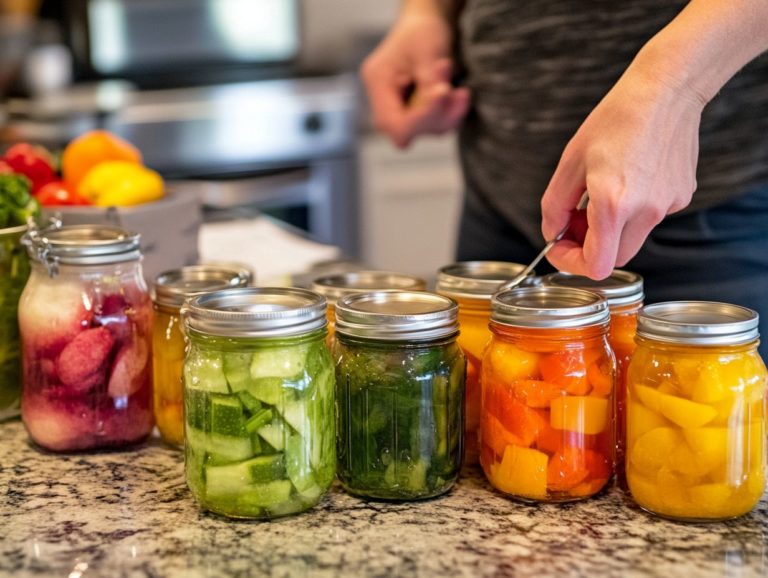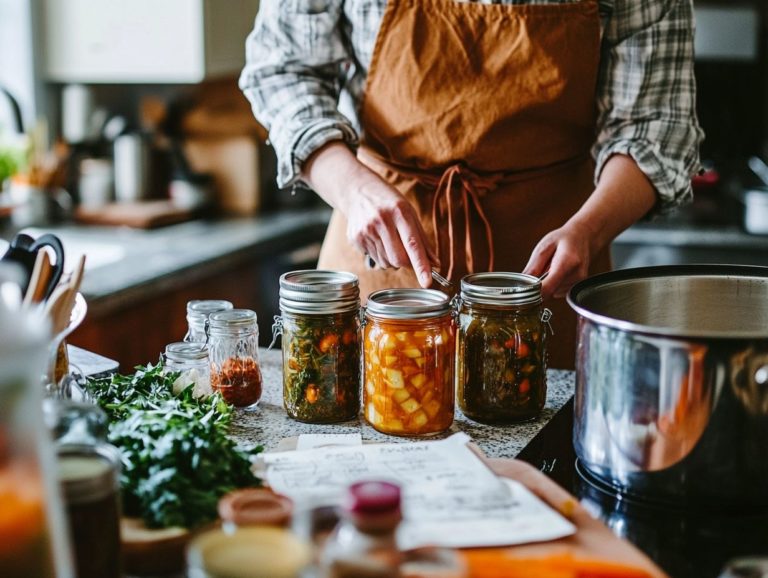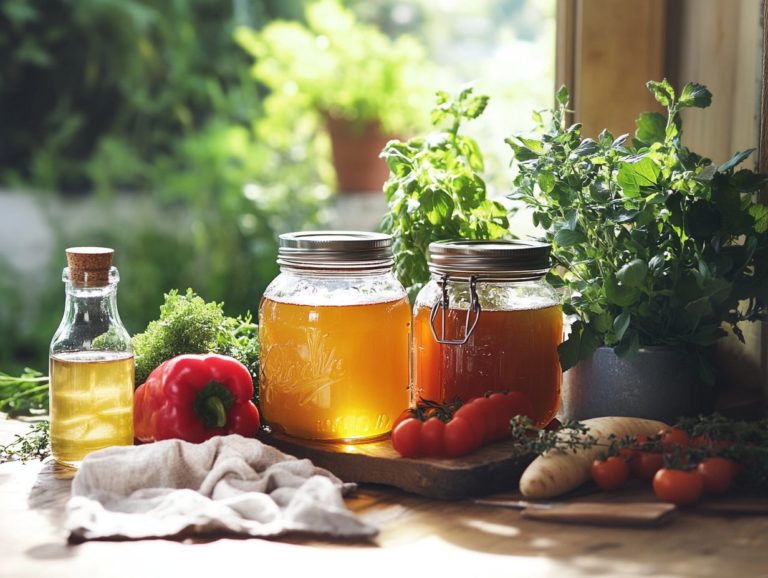How to Identify a Bad Canning Batch
Canning, especially home canning, is an excellent method for preserving your favorite foods. However, sometimes things don t go as planned. Spoilage can arise for several reasons, so it’s crucial to recognize the signs early to ensure food safety.
This article covers common spoilage causes. You will learn how to identify a bad batch and best practices for storing canned goods. You ll also find effective tips to prevent mishaps, including essential safety precautions, and learn what steps to take if you encounter a can that s gone awry.
Embrace your canning adventure! With the right techniques, you can ensure every jar is a success!
Contents
Key Takeaways:
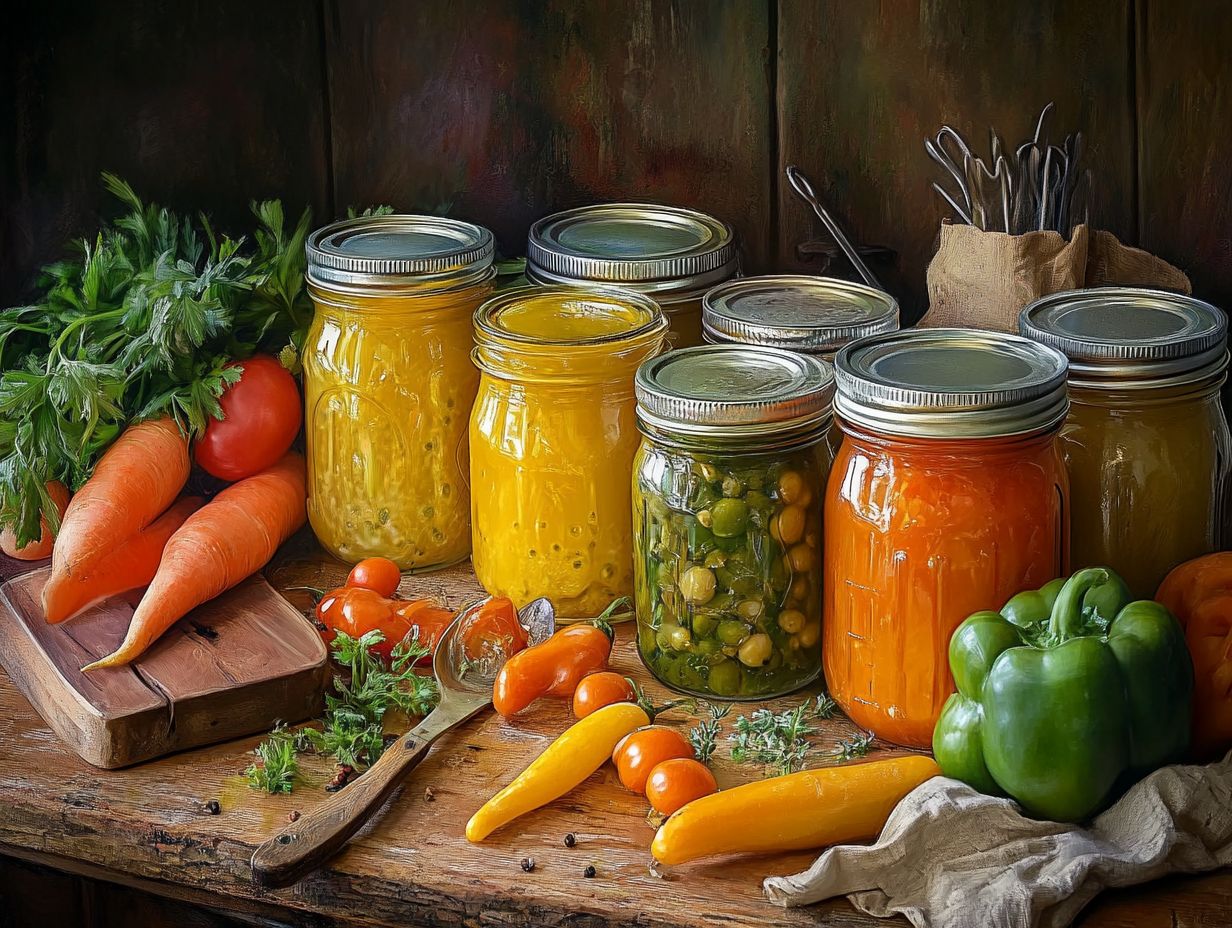
- Store your canned goods in a cool, dry place to keep them fresh!
- Watch for visual and sensory indicators: Mold, off-colors, and foul odors are signs of a bad canning batch.
- Prevent spoilage before it happens: Follow proper canning techniques, like sealing jars tightly and monitoring acidity.
What is Canning?
Canning is a wonderful method of food preservation that enables you to store various items, including fruits and vegetables, in jars or cans. By using techniques like boiling water or employing a pressure canner, you can eliminate foodborne pathogens such as botulism and Salmonella while creating a sealed environment.
This process not only extends the shelf life of your food but also preserves essential nutrients, flavor, and quality. It s a favored practice among home cooks and food preservation enthusiasts, especially those interested in fruit canning and jam making.
The USDA endorses canning methods to ensure safety and effectiveness, particularly for high-acid delights like pickles, jam, and other preserved items.
Why a Canning Batch Might Go Bad
Understanding why a canning batch might go awry is essential for maintaining food safety and preventing spoilage. For those facing issues, employing troubleshooting for better canning results can help. Improper canning techniques can lead to contamination from foodborne pathogens like botulism, E. coli, or Salmonella, making the contents unsafe to eat.
Factors that contribute to spoilage often stem from canning mistakes, such as inadequate sealing, incorrect processing times, or neglecting to monitor acidity and pH levels. Monitoring acidity means checking how acidic the food is, which helps prevent spoilage.
By recognizing these risks, you can take necessary precautions, such as conducting jar inspections and maintaining ideal headspace. These practices ensure the longevity of your canned goods and provide peace of mind with every jar you seal.
Possible Causes of Spoilage
Several factors can lead to spoilage in your canning efforts, including canning mistakes, liquid loss, air bubbles, and inadequate sealing. These issues compromise the safety and quality of your canned goods, increasing the risk of foodborne illness.
When you overlook these essential elements, you may unwittingly create conditions ripe for spoilage. Improper heating may fail to eliminate pathogens, while an insufficient vacuum seal allows air to intrude. Regularly inspecting your jars for signs of swelling or leakage is vital; these indicators can alert you to potential spoilage.
Additionally, conducting routine pH checks is significant for maintaining suitable acidity levels, effectively inhibiting the growth of harmful bacteria, including those responsible for botulism. Ensuring your canning equipment is properly sanitized and following recommended processing times and temperatures will significantly reduce these risks.
These preventive measures are essential for maintaining food safety and extending the shelf life of your preserved items, particularly when using a pressure gauge for accuracy.
Signs of a Bad Canning Batch
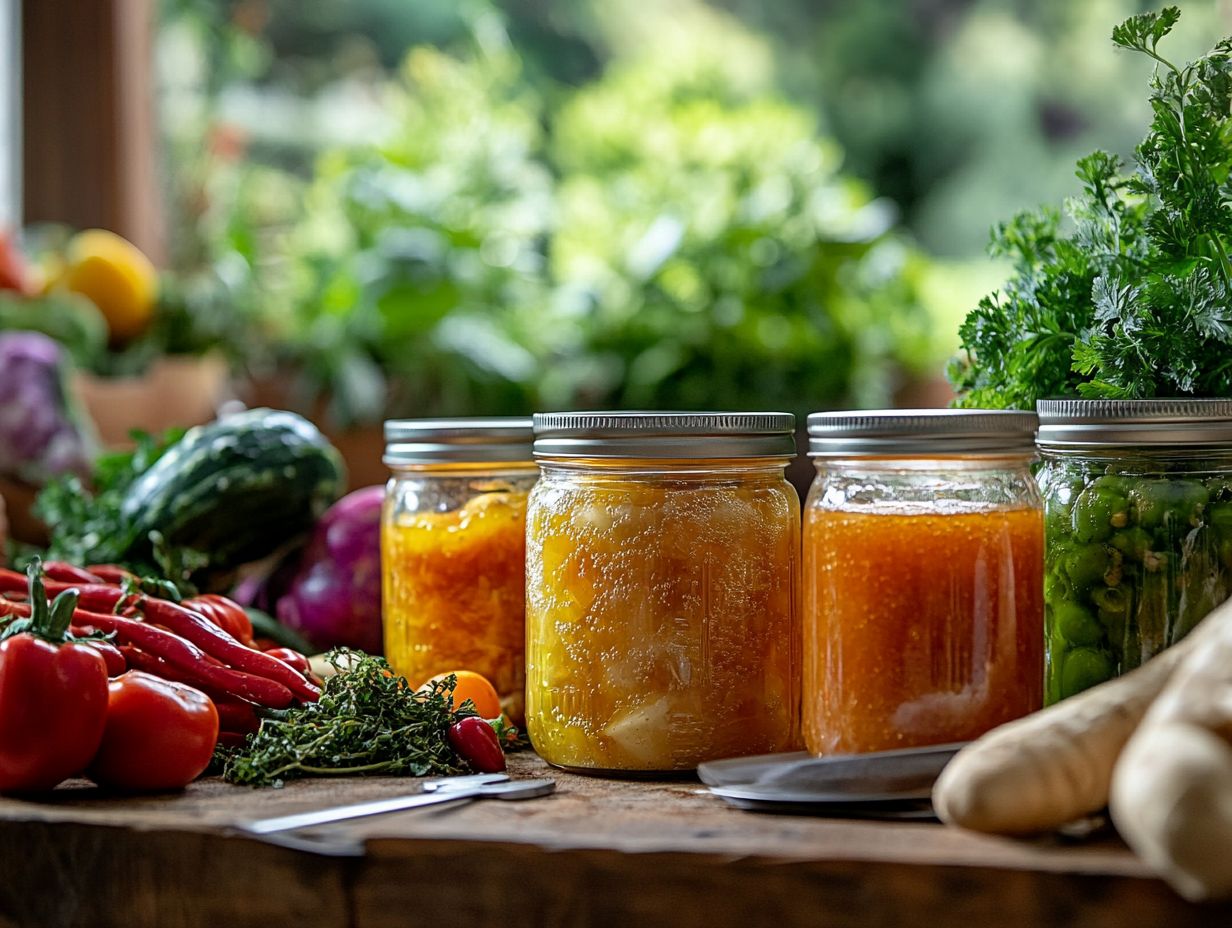
Identifying the signs of canning failures is crucial for ensuring your food safety. Spoiled canned goods can pose serious health risks and lead to foodborne illness.
Look out for common visual indicators like bulging lids, leakage, or any discoloration in the contents. Sensory cues are equally important unpleasant smells or unusual textures can signal trouble and indicate potential fermentation or spoilage.
By conducting regular jar inspections before use, you can spot these signs early, so you can safely dispose of them. This helps prevent potential foodborne illnesses, protecting your health and that of your family.
Visual and Sensory Indicators
Visual and sensory indicators are critical for assessing whether canned goods have spoiled. They offer immediate insights into the quality and safety of their contents, which is vital for ensuring kitchen safety.
It s important to know how to identify these signs. For instance, visual cues like rusty edges or separation in layers can signal spoilage. Sensory indicators, such as a sour smell or an off taste, act as warning signs that something might be amiss with the food, highlighting the importance of proper food storage.
Recognizing these signs not only helps you avoid foodborne illnesses but also underscores the importance of careful checking during food preparation and proper jar sealing techniques.
Thoroughly examine each jar to ensure a safer and more enjoyable mealtime experience, relishing in the fruits of your labor.
How to Properly Store Canned Goods
Proper storage of canned goods is essential for preserving their quality and safety, effectively preventing spoilage and extending shelf life. Start by confirming that your jars are sealed correctly and have undergone a thorough cooling process to ensure the seal’s integrity.
Once that s taken care of, place the jars in a cool, dark location to minimize temperature fluctuations that could jeopardize food safety. Check your jars regularly to catch issues before they become serious, allowing you to spot any potential issues, such as jar bottoms that may show signs of damage.
Best Practices for Long-Term Storage
Regarding long-term storage of canned goods, employing best practices is essential to ensure the quality and safety of your preserved food over time. Key practices include maintaining a consistent temperature away from direct sunlight, organizing your jars for easy access and inspection, and routinely checking for any signs of spoilage, such as damaged seals or discoloration, that may mean you need to check the acidity.
To further enhance the longevity of your stored items, consider labeling each jar with the date of canning, along with the type of food preserved. This simple step will help you prioritize using the oldest jars first.
Storing your jars on sturdy, stable shelves is crucial to prevent unnecessary breakage. Implementing a rotation system will keep your inventory fresh. It s also wise to keep an eye on humidity levels in your storage area, as excessive moisture can lead to mold growth on seals, compromising food quality.
By prioritizing these food safety practices, you can savor the fruits of your labor with peace of mind for many months to come, whether it be jams, pickles, or other delicious homegrown foods.
Preventing a Bad Canning Batch
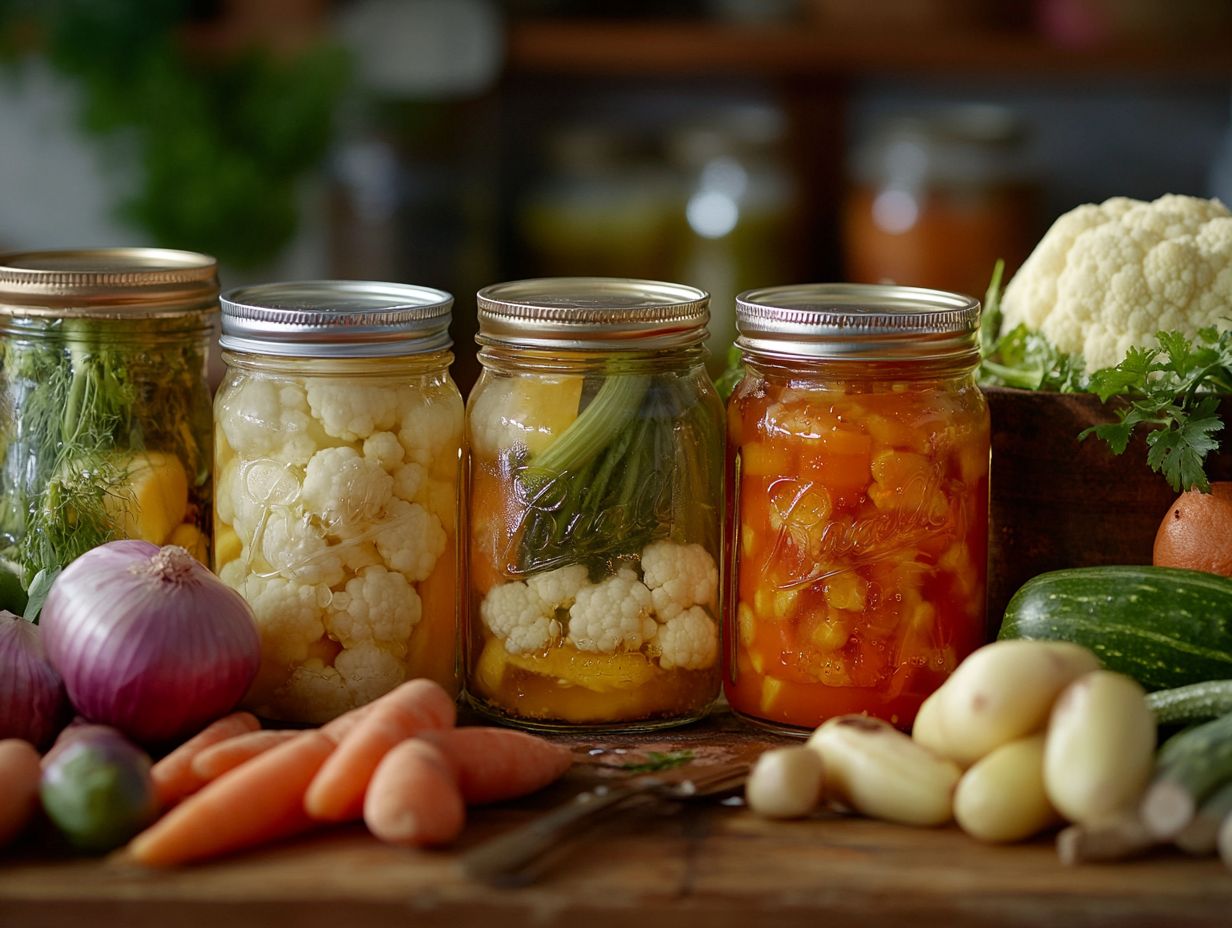
Preventing a bad canning batch requires a thoughtful blend of precise techniques, such as monitoring pH levels indicating how acidic or alkaline a food is and ensuring proper sealing. For more details, refer to our guide on troubleshooting canning jar preparation, along with rigorous safety measures to mitigate risks like spoilage and contamination.
Key practices include ensuring proper sterilization of jars and understanding the boiling point of water for safe processing.
- Ensure that jars are impeccably sterilized.
- Adhere to the recommended processing times.
- Conduct regular inspections of the jars to identify any potential issues early on.
By following these guidelines, you can significantly diminish the chances of facing problems with your preserved foods, ensuring your canning endeavors yield nothing short of success and delightful flavors!
Tips for Proper Canning Techniques
Implementing proper canning techniques is essential for ensuring food safety and preventing spoilage in your home canning endeavors. Key tips include properly sterilizing jars, monitoring pH levels for high-acid foods like applesauce and tomatoes, and selecting the appropriate processing method, whether that s a pressure canner or a boiling water bath.
To make the most of these practices, start by thoroughly cleaning all your equipment and ensuring that the jars are heated adequately before you begin filling them.
Understanding the significance of pH levels is crucial for effective food preservation, as it dictates whether you can safely process your food using the boiling water method or if you need a pressure canner for low-acid foods.
Adhering strictly to the recommended processing times is vital, guaranteeing that harmful germs are effectively eliminated. Regularly checking the seal integrity after cooling is key to maintaining the quality and safety of your preserved foods, ensuring they remain free from foodborne pathogens.
What to Do with a Bad Canning Batch
When you encounter a bad canning batch, understanding how to manage the situation is essential for ensuring food safety and mitigating potential health risks associated with spoilage. It’s crucial to know the signs you’re using faulty canning equipment, and above all, refrain from consuming any food that shows signs of spoilage, such as bulging lids or off odors, as these can indicate the presence of harmful bacteria.
Instead, safely dispose of any spoiled jars by sealing them in sturdy trash bags. Use this moment to learn and improve for your next canning adventure!
Safe Disposal and Next Steps
Safe disposal of a bad canning batch is crucial for preventing contamination and upholding food safety standards in your kitchen. Familiarizing yourself with troubleshooting common canning problems can help ensure that no harmful bacteria or toxins linger in your environment.
By carefully sealing spoiled jars in sturdy trash bags, you minimize any potential exposure to harmful bacteria or toxins that may have developed from the canning process. Resist the urge to salvage or consume the contents; doing so can lead to serious health risks, including foodborne illness.
Once you’ve discarded the spoiled goods, reflect on the entire canning process. Evaluate the ingredients you used, inspect your equipment, and confirm that you followed proper sterilization techniques. This reflective practice not only enhances your future canning endeavors but also reinforces your commitment to food safety and responsible disposal methods, ultimately creating a healthier cooking environment.
Frequently Asked Questions
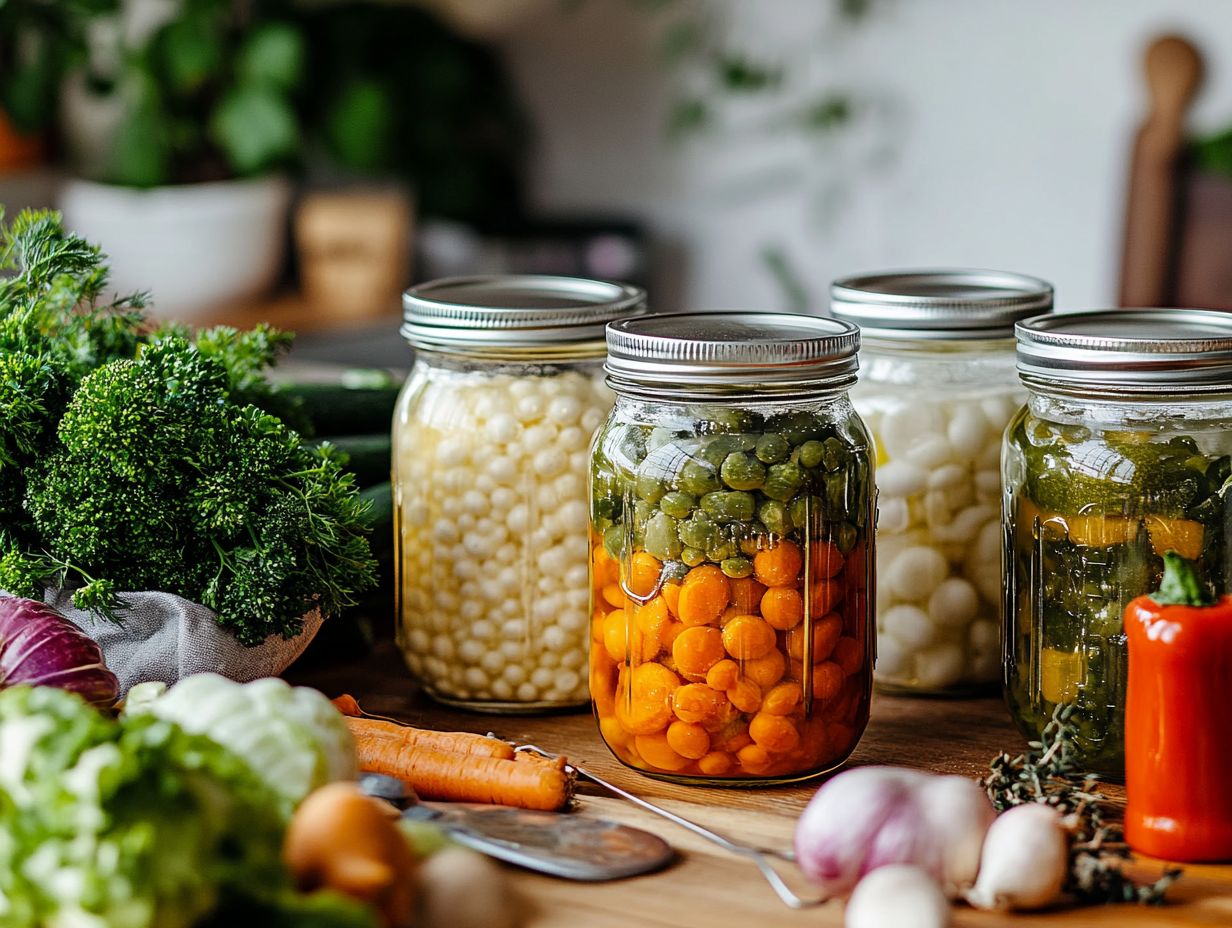
What is a bad canning batch?
A bad canning batch refers to jars of food that have not been stored correctly, resulting in potential spoilage or contamination. This can be caused by various factors, such as incorrect processing, outdated or damaged equipment, or using contaminated ingredients. To avoid these issues, consider troubleshooting your canning process.
How can I tell if a canning batch has gone bad?
Here are some warning signs you can’t ignore! Signs of botulism can include a bulging lid and unusual smells, which are critical to watch for in canned goods.
Several signs can indicate a bad canning batch. Look for a bulging lid, leaking or rusted cans, unusual smells, a change in color of the food, or an off-taste. If you notice any of these signs, consult resources on understanding canning process failures and don’t consume the canned food.
What should I do if I suspect a canning batch is bad?
Think a canning batch has gone bad? Don’t eat it! Instead, carefully dispose of the jar and its contents, ensuring it’s out of reach of animals and children. For more information on how to spot issues, check out identifying canning jar defects.
When it comes to food safety, it’s better to be safe than sorry.
What can cause a canning batch to go bad?
Improper canning techniques can result in a bad batch. This includes not processing the jars for the recommended amount of time or not using enough acid in foods that are low in acid, such as tomatoes. Being aware of signs of canning liquid fermentation can help you troubleshoot and ensure a successful canning process.
Using damaged or dirty equipment, or storing the jars in unsuitable conditions, can also lead to spoilage.
How can I prevent a bad canning batch?
To prevent a bad canning batch, follow proper canning procedures and use fresh, high-quality ingredients. It’s also important to recognize the signs of improperly canned food and regularly inspect and maintain your canning equipment.
Store canned food in a cool, dark, and dry place.
Is it safe to eat from a canning batch that has gone bad?
No, it is not safe to consume food from a bad canning batch. Consuming spoiled or contaminated canned food can lead to foodborne illnesses and can be potentially life-threatening.
When in doubt, throw it out.


